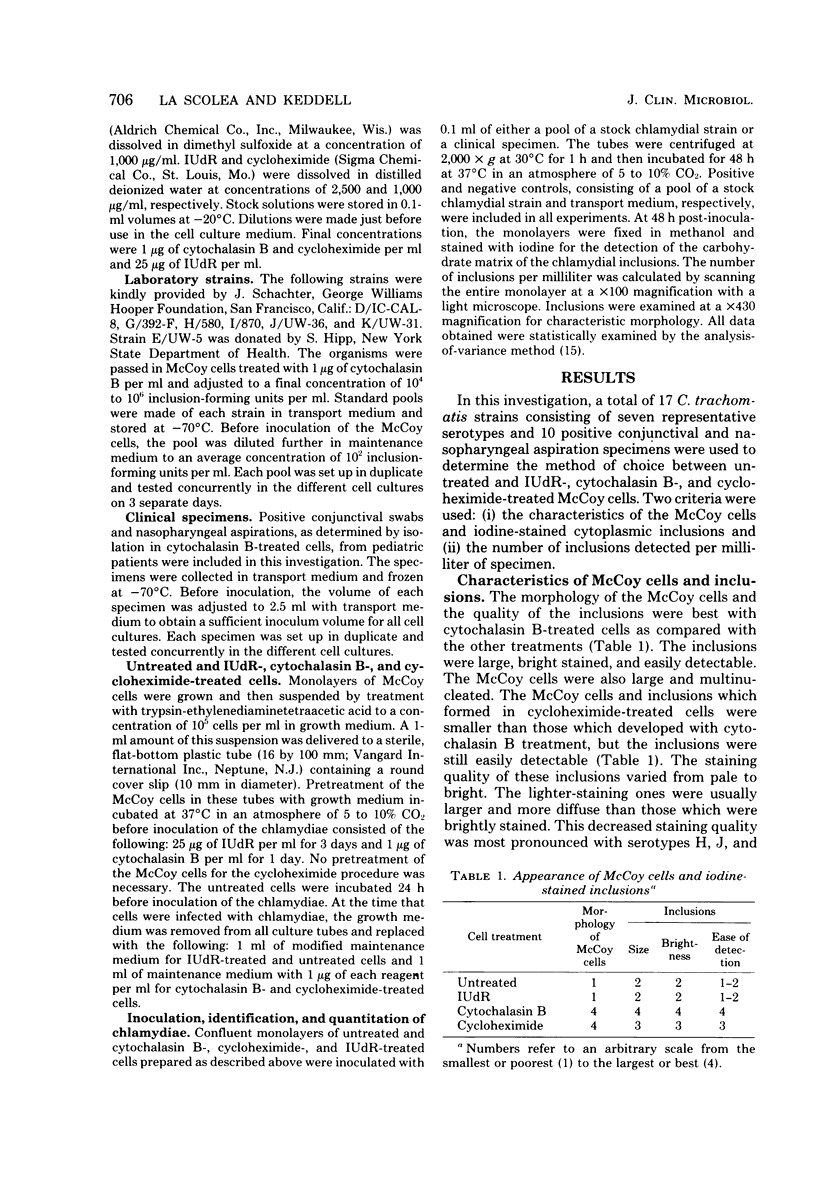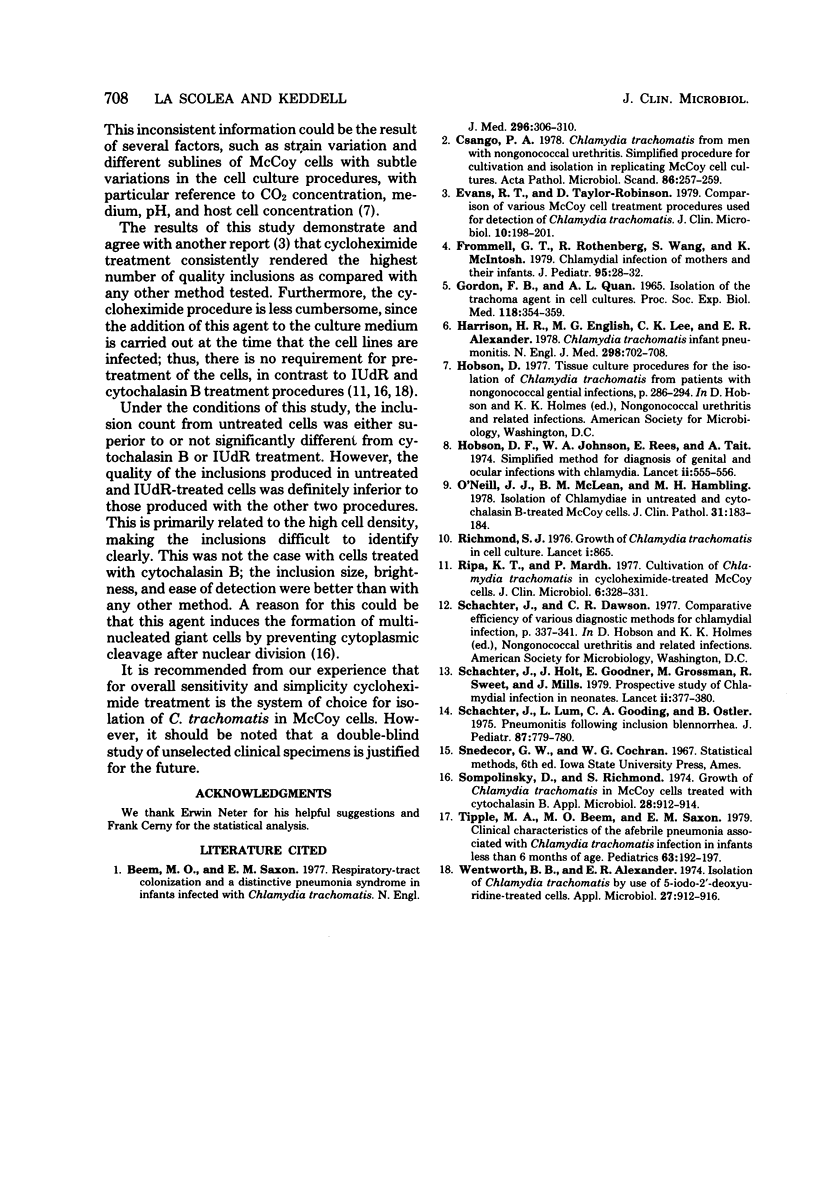Abstract
In this study, 5-iodo-2'-deoxyuridine-, cytochalasin B-, and cycloheximide-treated and untreated McCoy cells were inoculated with representative strains of Chlamydia trachomatis serotypes, as well as with clinical specimens from a pediatric population, and the quality and quantity of the cytoplasmic inclusions were examined. Cycloheximide treatment consistently rendered the highest number of quality inclusions per milliliter of any method tested for both the laboratory strains (P less than 0.001) and the clinical isolates (P less than 0.01). The inclusion counts in untreated McCoy cells were either higher than or not significantly different from those in 5-iodo-2'-deoxyuridine- an cytochalasin B-treated cells. However, the quality of the inclusions, using the criteria of size, brightness, and ease of detection produced in untreated and 5-iodo-2'-deoxyuridine-treated cells, was inferior to the quality of those obtained by other procedures. Cells treated with cytochalasin B had the best-quality inclusions as compared with those treated by any other method. It is recommended from our experience that for overall sensitivity and simplicity cycloheximide treatment is the method of choice for isolation of C. trachomatis in McCoy cells.
Full text
PDF



Selected References
These references are in PubMed. This may not be the complete list of references from this article.
- Beem M. O., Saxon E. M. Respiratory-tract colonization and a distinctive pneumonia syndrome in infants infected with Chlamydia trachomatis. N Engl J Med. 1977 Feb 10;296(6):306–310. doi: 10.1056/NEJM197702102960604. [DOI] [PubMed] [Google Scholar]
- Csángó P. A. Chlamydia trachomatis from men with non-gonococcal urethritis. Simplified procedure for cultivation and isolation in replicating McCoy cell culture. Acta Pathol Microbiol Scand B. 1978 Aug;86(4):257–259. doi: 10.1111/j.1699-0463.1978.tb00041.x. [DOI] [PubMed] [Google Scholar]
- Evans R. T., Taylor-Robinson D. Comparison of various McCoy cell treatment procedures used for detection of Chlamydia trachomatis. J Clin Microbiol. 1979 Aug;10(2):198–201. doi: 10.1128/jcm.10.2.198-201.1979. [DOI] [PMC free article] [PubMed] [Google Scholar]
- Frommell G. T., Rothenberg R., Wang S., McIntosh K. Chlamydial infection of mothers and their infants. J Pediatr. 1979 Jul;95(1):28–32. doi: 10.1016/s0022-3476(79)80077-3. [DOI] [PubMed] [Google Scholar]
- GORDON F. B., QUAN A. L. ISOLATION OF THE TRACHOMA AGENT IN CELL CULTURE. Proc Soc Exp Biol Med. 1965 Feb;118:354–359. doi: 10.3181/00379727-118-29841. [DOI] [PubMed] [Google Scholar]
- Harrison H. R., English M. G., Lee C. K., Alexander E. R. Chlamydia trachomatis infant pneumonitis: comparison with matched controls and other infant pneumonitis. N Engl J Med. 1978 Mar 30;298(13):702–708. doi: 10.1056/NEJM197803302981303. [DOI] [PubMed] [Google Scholar]
- Hobson D., Johnson F. W., Rees E., Tait I. A. Simplified method for diagnosis of genital and ocular infections with Chlamydia. Lancet. 1974 Sep 7;2(7880):555–556. doi: 10.1016/s0140-6736(74)91879-0. [DOI] [PubMed] [Google Scholar]
- O'Neill J. J., McLean B. M., Hambling M. H. Isolation of chlamydiae in untreated and Cytochalasin B treated McCoy cells. J Clin Pathol. 1978 Feb;31(2):183–184. doi: 10.1136/jcp.31.2.183. [DOI] [PMC free article] [PubMed] [Google Scholar]
- Richmond S. J. Letter: Growth of Chlamydia trachomatis in cell culture. Lancet. 1976 Apr 17;1(7964):865–865. doi: 10.1016/s0140-6736(76)90524-9. [DOI] [PubMed] [Google Scholar]
- Ripa K. T., Mårdh P. A. Cultivation of Chlamydia trachomatis in cycloheximide-treated mccoy cells. J Clin Microbiol. 1977 Oct;6(4):328–331. doi: 10.1128/jcm.6.4.328-331.1977. [DOI] [PMC free article] [PubMed] [Google Scholar]
- Schachter J., Grossman M., Holt J., Sweet R., Goodner E., Mills J. Prospective study of chlamydial infection in neonates. Lancet. 1979 Aug 25;2(8139):377–380. doi: 10.1016/s0140-6736(79)90400-8. [DOI] [PubMed] [Google Scholar]
- Schachter J., Lum L., Gooding C. A., Ostler B. Pneumonitis following inclusion blennorrhea. J Pediatr. 1975 Nov;87(5):779–780. doi: 10.1016/s0022-3476(75)80309-x. [DOI] [PubMed] [Google Scholar]
- Sompolinsky D., Richmond S. Growth of Chlamydia trachomatis in McCoy cells treated with cytochalasin B. Appl Microbiol. 1974 Dec;28(6):912–914. doi: 10.1128/am.28.6.912-914.1974. [DOI] [PMC free article] [PubMed] [Google Scholar]
- Tipple M. A., Beem M. O., Saxon E. M. Clinical characteristics of the afebrile pneumonia associated with Chlamydia trachomatis infection in infants less than 6 months of age. Pediatrics. 1979 Feb;63(2):192–197. [PubMed] [Google Scholar]
- Wentworth B. B., Alexander E. R. Isolation of Chlamydia trachomatis by use of 5-iodo-2-deoxyuridine-treated cells. Appl Microbiol. 1974 May;27(5):912–916. doi: 10.1128/am.27.5.912-916.1974. [DOI] [PMC free article] [PubMed] [Google Scholar]


